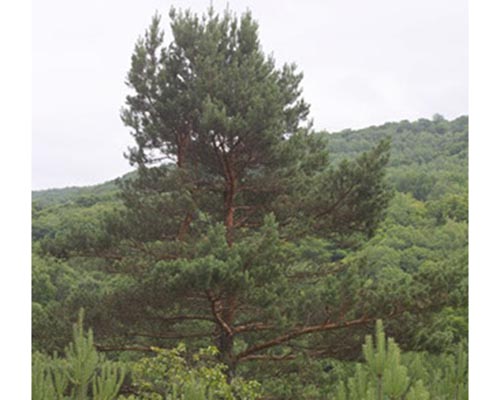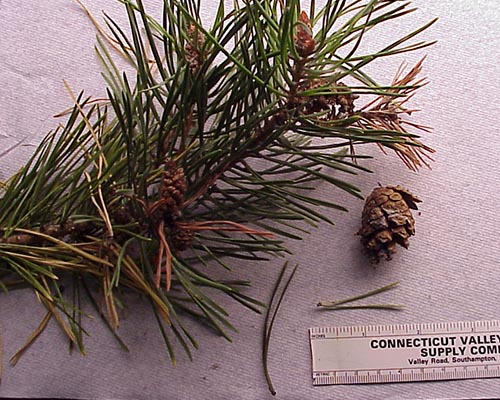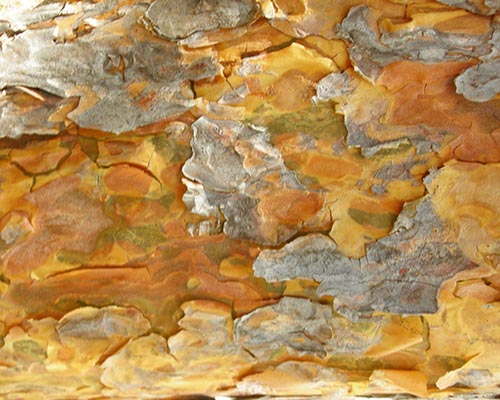When you walk this trail, how much of what you see is natural and how much is not? What exactly is a “native” species? Are all non-native species “invasive?” Even if a non-native species is not invasive, is it bad? Or could it actually be good?
Scots pine or Scotch pine (Pinus sylvestris) provides an example of the complexity of these questions. It is an evergreen conifer, distinctive because of its long, bare trunk and branches topped by rounded masses of needles in bundles, with two 2-inch needles per bundle. Native to Europe and Asia, it is believed to have been brought to North America by early European settlers and has thus been here for several hundred years. At what point do we give a species a “pass?” In point of fact, Scots pine has been chosen to illustrate this station because it is generally given a pass. Many other non-native species in the Adirondacks are removed when sighted, but the Scots pine at this site is likely to remain.
And yet Scots pine is not harmless. It flourishes on sandy soils and spreads aggressively wherever there is high light availability, such as along firebreaks and roadsides. As it spreads, it reproduces so quickly that it covers the ground with a mat of seedlings, strangling other species. The USDA defines invasive plants as “both non-native and able to establish on many sites, grow quickly, and spread to the point of disrupting plant communities or ecosystems.” Scots pine is listed as invasive in Ontario, Canada, Michigan and Wisconsin; but it presents less of a threat here, where it is controlled by climate, soil and diseases such as pine wilt nematode (Bursaphelenchus xylophilus) and scleroderris canker (Gremmeniella abietina). Invasiveness is context-dependent.
Furthermore, Scots pine is in many ways a good thing. When it is not invasively disrupting ecosystems, it is an important source of timber and pulp in forestry, and is deliberately cultivated. It is also a popular Christmas tree species. In fact it is the most common Christmas tree in the U.S., in part because its natural drought resistance means that it retains its needles well. Humans tend to be selfish. We often evaluate nature according to its utility to us. This is formalized in the “ecosystem services” approach to management and conservation. From this perspective, Scots pine may sometimes be invasive, but its usefulness outweighs its invasiveness in most contexts. Often, however, there is no ambiguity of this sort. There is no question that species such as the zebra mussel or purple loosestrife are highly invasive and highly damaging to both natural ecosystems and human priorities. It is entirely possible that Scots pine will become more problematic over time, and our current tolerance of it may look foolish in hindsight. It is hard to know.
Suppose one could wave a magic wand and eliminate all of the non-native species from this trail? Would what was left be “natural?” Prior to the arrival of Europeans, ecosystems in North America were not in a natural state, because Native Americans modified them in several ways. There is strong evidence that Native Americans used fire extensively to reshape their environment, converting forests to grasslands and clearing away underbrush to create “park-like” woodlands for a variety of purposes. There is also substantial evidence that the first Native Americans, who crossed the Bering Strait into North America at the end of the last Ice Age some 15,000 years ago, caused a great wave of extinctions of large animals, perhaps by hunting. This event, called the Late Pleistocene Extinction, eliminated many species that once existed in North America including native species of lion, cheetah and llamas along with mammoths and mastodons.
In fact, the wildlife of North America used to resemble that of the African savannah in many ways, but since the arrival of the first humans here, it has changed immensely. Some propose that we ought to introduce African species such as lions and elephants to North America to try to restore something like the functioning ecosystems that were once here. If we went ahead with this so-called “Pleistocene Rewilding” would the species that we introduced be non-native and invasive? Or, would they be essentially native, in spirit even if not literally? Would such a change be good or bad? What do you think?



